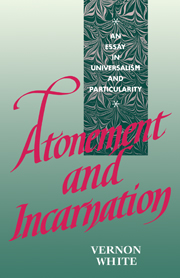Book contents
- Frontmatter
- Contents
- Introduction
- 1 The claim
- 2 On having lived too long and seen too much
- 3 The work of Christ (On trying to conceive how ‘things are not as they were’)
- 4 Two recent contributions
- 5 Creating an atonement model
- 6 The person of Christ (On trying to conceive how the Word became Flesh)
- 7 A moral demand: conditions for real reconciliation
- 8 Anthropocentricity, imperialism, and evangelism: an ethical postscript
- Notes
- Bibliography
- Index
6 - The person of Christ (On trying to conceive how the Word became Flesh)
Published online by Cambridge University Press: 21 September 2009
- Frontmatter
- Contents
- Introduction
- 1 The claim
- 2 On having lived too long and seen too much
- 3 The work of Christ (On trying to conceive how ‘things are not as they were’)
- 4 Two recent contributions
- 5 Creating an atonement model
- 6 The person of Christ (On trying to conceive how the Word became Flesh)
- 7 A moral demand: conditions for real reconciliation
- 8 Anthropocentricity, imperialism, and evangelism: an ethical postscript
- Notes
- Bibliography
- Index
Summary
When it comes to self-understanding Christian theology is no stranger to tough tasks. It will always be difficult, almost perverse, to keep struggling with an uncompromising theodicy. Equally, it has always been hard to conceive a doctrine of incarnation. We are not in an entirely new situation if we find the doctrine under pressure.
Moreover, to require a doctrine so specifically defined as to allow the eternal God and the historical man Jesus to ‘share a common identity as the subject of the same incarnational experiences’, and to promulgate this in the late twentieth-century aftermath of idealism, empiricism, and positivism, invites even greater difficulties. Separately and cumulatively these intellectual fashions have formed a heady brew. It is easy to see why some deem the traditional doctrine of incarnation to have been irredeemably poisoned by them.
Although at odds with each other in many respects, all these trends have had a common consequence for christological method, which Pannenberg popularized in his observation that it has changed from ‘from above’, to ‘from below’; that is, instead of asking how the transcendent God could become man (or a man), we should ask how a man (Jesus) could show us God. They have also resulted in common (reductionist) christological conclusions.
Thus an idealistic philosophy which attempts to embrace the whole of reality within a single scheme of interpretation will interpret all particulars as expressions of this unifying category.
- Type
- Chapter
- Information
- Atonement and IncarnationAn Essay in Universalism and Particularity, pp. 69 - 86Publisher: Cambridge University PressPrint publication year: 1991

